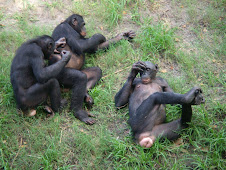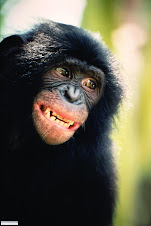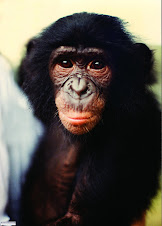



In the early 1990's, The Zairian Institute for the Conservation of Nature sponsored a educational pamphlet tied to a census of eastern lowland gorillas led by Jeff Hall of the Wildlife Conservation Society (Bronx Zoo). Kizito and I wrote and illustrated a culturally sensitive story that talked about gorillas and elephants. We used a play on words with "Monganga" which was the word for "Doctor" as well as the brand name of a popular bar soap.
The cover featured a forest scene with a village family. The riches of the forest were symbolically represented with a spear, fish, and a basket heaped with the harvest. The text reads:
"WE SHARE THE FOREST We have known our forest for many, many years. It is our home and will be the home of our children and children's children. The forest is bountiful to those who understand it. Here we find everything we need. We hunt and fish for the animals that feed us. Our forest gives us medicine, fruit, rope, nuts, paints, and candles.
"In return, we share the forest with other creatures. We need to take good care of our land so it will continue to sustain us. The following pages will describe the two largest animals we find in the forest. See how they are part of our world.
(Page two) "THE GIFT OF THE ELEPHANT The elephant is the largest animal in the forest. He is also its great protector. He could be called "Monganga Ya Zamba" (Forest Doctor) for the care he gives it.
"He is practically the master constructor of the forest, if you like. He knocks down trees to eat, which makes clearings for the sun to penetrate and start new plant life.
"But the greatest gift of our doctor is in his droppings. For these contain large seeds of giant fruits which only the elephant is capable of eating. These seeds are not digested, but deposited in the dung, which is ideal for germination. Some trees in our forest can only be planted by first passing through an elephant. (The illustration here is of a seeding thinking, "Thanks, forest doctor!" as it sprouts up from an elephant pile, complete with flies).
(Page three) "The gorilla is renown the world over for his huge size, his strength, and his intelligence. In truth, the gorilla does not use his enormous powers for aggression. The dominant male will charge anything that endangers his family. But he stops short, only to threaten with a roar. His size alone is enough to deter enemies.
"Gorilla infants pass their childhood with few worries. They spend their first years learning how to be a gorilla. They follow the family's examples to learn what is edible, what to fear and avoid (like snakes and toxic plants) and most importantly, how to become good parents themselves. Gorillas eat leaves, fruits, shoots, stems, flowers, and ants.
(Page four) "This man is a zoologist. His name is Sabuni and he is studying the relationship between large mammals and plants. In this image you can see that Sabuni has a certain rapport with an adult male gorilla! This is, because, near Bukavu and near Goma, specialists have habituated some groups to the presence of humans. Quietly and calmly approached, the gorillas do not flee.
"Often the zoologist wonders about the use of the surrounding forest. How will man take care of it in the next century, he asks? What will happen to us that depend on the forest if gorillas and elephants were no more?"
Our pamphlet was a labor of love. It was printed in Swahili and tested for interpretation by the intended audience. Humans and the relationship with and benefit from the forest was emphasized. It was printed in at a Kinshasa printer, and used only two colors, green and black, which meant delicate half-tones done by hand to achieve the greys and light greens. It. Even the spacing of the text around the half circle above the gorilla had to be adjusted one letter at a time on a template, due to lack of sophisticated computer software.













No comments:
Post a Comment